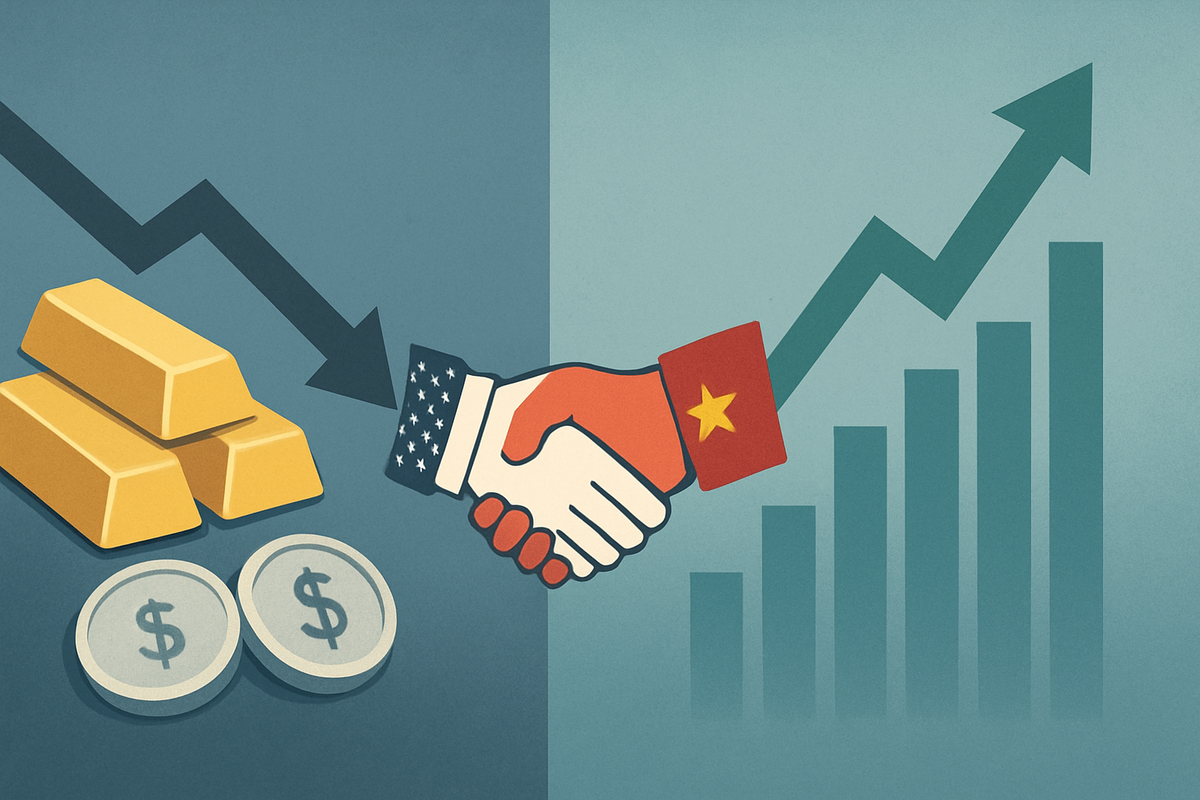
October 27, 2025 – Global financial markets are experiencing a significant pivot as burgeoning optimism for a US-China trade deal fuels a robust "risk-on" sentiment, leading to a sharp and immediate decline in the prices of traditional safe-haven assets, gold and silver. Investors, buoyed by the prospect of de-escalating trade tensions and renewed global economic stability, are rapidly reallocating capital from precious metals into riskier, growth-oriented equities, signaling a collective sigh of relief across financial centers worldwide.
This dramatic shift underscores a profound change in investor psychology, where the allure of potential economic expansion now overshadows the traditional appeal of bullion as a hedge against uncertainty. The immediate implications are clear: a period of volatility for precious metals, while equity markets celebrate what could be a pivotal moment for international trade and corporate profitability.
US-China Trade Optimism Triggers Market Re-evaluation
The catalyst for this market upheaval is the widespread belief that a substantial US-China trade agreement is on the horizon. High-level negotiations conducted in Kuala Lumpur throughout October have reportedly culminated in a "very substantial framework" for a deal. This breakthrough sets the stage for a highly anticipated meeting between US President Donald Trump and Chinese President Xi Jinping in South Korea on October 30, 2025, where the agreement is expected to be finalized. The primary immediate benefit is the likely averting of 100% tariffs on Chinese imports that were slated to commence on November 1, a move that had cast a long shadow over global trade.
Key components of the preliminary agreement reportedly include China's commitment to substantial purchases of US soybeans and a deferral of its rare earth export controls for a year, indicating a tangible de-escalation of trade hostilities. This news has electrified markets. On Monday, October 27, 2025, major US equity indices, including the Dow Jones Industrial Average, S&P 500, and Nasdaq Composite, all opened at record highs. Asian and European markets mirrored this enthusiasm, with Japan's Nikkei 225 closing above 50,000 for the first time ever and Seoul's index surpassing 4,000. Sectors such as technology, semiconductors, and agriculture are particularly buoyant, anticipating direct benefits from reduced tariffs and renewed trade flows.
Conversely, precious metals, which had enjoyed a robust rally amidst earlier trade uncertainties and geopolitical tensions, have suffered a significant downturn. Spot gold saw a notable decline of as much as 1.4% on October 27, trading near $4,053 an ounce, extending a 3.3% loss from the preceding week. COMEX gold futures decreased by $42.90 to $4094.90 per troy ounce. This marks a sharp correction from the record highs of $4,380-$4,398 per ounce touched earlier in October. Silver mirrored gold's trajectory, with spot prices sliding 1.59% to $47.83 per ounce, following an 11.3% plunge the previous week—its steepest weekly decline since September 2020. COMEX silver futures traded 1.44% lower at $47.88 per ounce, down from an October high of $53.76. The strong US dollar, bolstered by renewed trade optimism, has also contributed to the decline, making dollar-denominated gold and silver more expensive for international buyers. Investors are clearly unwinding their safe-haven positions, engaging in profit-taking after months of strong performance.
Companies Navigating the 'Risk-On' Tides
The shift towards a 'risk-on' environment will undoubtedly create winners and losers among public companies, particularly those tied to the commodities market and global trade. Precious metal miners are among the most immediate casualties. Companies like Barrick Gold (NYSE: GOLD), Newmont (NYSE: NEM), and Wheaton Precious Metals (NYSE: WPM) are likely to see their stock prices pressured by falling gold and silver prices. Lower metal prices directly impact their revenue and profitability, potentially leading to reduced exploration budgets or even write-downs of reserves if the price decline is sustained. Silver miners such as Pan American Silver (NASDAQ: PAAS) and First Majestic Silver (NYSE: AG) will face similar headwinds, given silver's dual role as both a monetary metal and an industrial commodity. While industrial demand for silver might see a boost from improved economic outlooks, its safe-haven appeal is currently being overshadowed.
On the flip side, companies heavily reliant on global trade, particularly those with significant exposure to US-China commerce, stand to gain substantially. Technology giants, semiconductor manufacturers, and agricultural commodity producers are poised for a rebound. Companies like Apple (NASDAQ: AAPL), which has extensive supply chains in China, and semiconductor firms such as NVIDIA (NASDAQ: NVDA) and Taiwan Semiconductor Manufacturing Company (NYSE: TSM), could benefit from reduced tariff uncertainties and improved consumer confidence. Agricultural companies, especially those dealing in soybeans, will see direct benefits from China's commitment to increased purchases. Industrial companies and logistics providers, which thrive on robust global trade flows, will also likely experience a boost in activity and profitability.
Furthermore, a general 'risk-on' environment tends to favor cyclical stocks—companies whose performance is closely tied to the overall economic cycle. This includes sectors like industrials, materials, financials, and consumer discretionary. Banks, for instance, could benefit from rising interest rates (as bond yields rise) and increased lending activity in a more confident economic climate. Energy companies might also see increased demand as global economic activity picks up. Investors are likely to rotate out of defensive sectors, which performed well during periods of uncertainty, and into these growth-oriented cyclical plays, leading to a re-evaluation of portfolios across the board.
Wider Significance and Historical Context
This event marks a significant turning point, reflecting broader industry trends of globalization and interconnectedness. The resolution, or even the strong prospect of resolution, of a major trade dispute like the US-China trade war has far-reaching ripple effects. It reduces input costs and market access barriers for countless businesses, potentially boosting corporate earnings and consumer spending globally. Competitors and partners across various industries, from automotive to electronics, will feel the positive impact of a more stable and predictable trade environment. For instance, companies that had diversified supply chains away from China due to tariff fears might now reconsider their strategies, potentially leading to new investment flows and partnerships.
Regulatory and policy implications are also substantial. A successful trade deal could set a precedent for future international trade negotiations, emphasizing diplomacy over protectionism. It might also reduce the urgency for governments to implement protectionist policies, fostering a more open global trading system. From a historical perspective, periods of de-escalating geopolitical or economic tensions have often led to similar shifts away from safe-haven assets. For example, during the post-Cold War era or after major financial crises, once stability returned, investors often moved out of gold and into equities. This current movement aligns with the historical pattern where gold's appeal diminishes when perceived risks to the global economic system recede. The significant decline in gold and silver prices, despite lingering expectations of interest rate cuts from the Federal Reserve (with high probabilities of 25 basis point cuts in November and December 2025 due to softer US inflation), underscores how powerful the trade deal narrative currently is, overriding traditional drivers for precious metals.
What Comes Next: Navigating the New Landscape
In the short term, the trajectory of precious metals will largely depend on the successful finalization of the US-China trade deal in South Korea and the market's perception of its comprehensiveness and durability. Any hiccups or unexpected delays could quickly reignite safe-haven demand, leading to a rebound for gold and silver. However, if the deal proceeds as anticipated, the 'risk-on' sentiment is likely to persist, potentially pushing equity markets higher and keeping pressure on bullion prices. Investors should closely monitor official statements from both US and Chinese leaders, as well as the specific details of the signed agreement.
Long-term possibilities are more nuanced. While a trade deal removes a major headwind, other factors could still influence precious metals. Geopolitical flashpoints, inflation trends, and the pace of global economic growth will continue to play a role. Should the global economy enter a period of sustained growth, industrial demand for silver, for example, could eventually provide some support. For gold, its role as a hedge against inflation or currency debasement could resurface if central banks continue with accommodative monetary policies, even if trade tensions ease. Potential strategic pivots for mining companies might include cost-cutting measures, diversification into other minerals, or a renewed focus on high-grade assets to maintain profitability in a lower price environment.
Market opportunities will emerge in sectors poised to benefit from renewed global trade and economic confidence. Investors might look for undervalued cyclical stocks, companies with strong international exposure, and those directly benefiting from the terms of the trade deal. Challenges for precious metals investors will include adapting to a potentially prolonged period of lower prices and reconsidering their portfolio allocations. Potential scenarios range from a continued bullish run for equities and a bearish trend for precious metals if the trade deal holds, to a quick reversal if new geopolitical or economic uncertainties arise, or if the trade deal proves to be less impactful than currently hoped.
A New Chapter for Global Markets
The current decline in precious metals, driven by the surging 'risk-on' sentiment surrounding a potential US-China trade deal, marks a significant inflection point for financial markets. The immediate takeaway is a clear rotation of capital from safe-haven assets to growth-oriented investments, reflecting a collective belief that a major source of global economic uncertainty is being resolved. This shift highlights the profound impact that geopolitical developments and trade policies have on asset prices and investor behavior.
Moving forward, the market will be keenly focused on the implementation and long-term stability of the US-China trade agreement. While the immediate outlook for gold and silver appears challenging, their fundamental role as hedges against inflation and systemic risk means they will always retain some appeal, particularly if new uncertainties emerge or if inflationary pressures unexpectedly build. For investors, this period necessitates a careful assessment of portfolio diversification. Those heavily weighted in precious metals might consider rebalancing, while those seeking growth could explore opportunities in sectors poised to benefit from improved global trade.
Ultimately, this event underscores the dynamic nature of financial markets and the constant interplay between geopolitics, economics, and investor psychology. What investors should watch for in the coming months includes the concrete outcomes of the US-China trade deal, any subsequent policy changes from major central banks, and the actual impact of reduced trade tensions on corporate earnings and global economic growth. The 'risk-on' tide is currently strong, but vigilance remains paramount in an ever-evolving market landscape.
This content is intended for informational purposes only and is not financial advice





